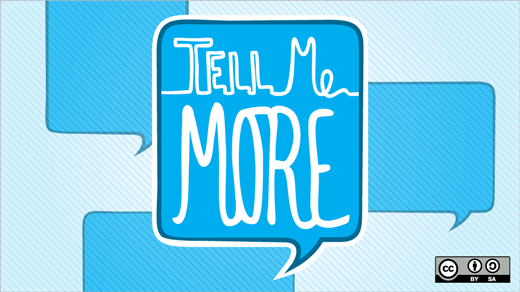In August, the Fedora Project held its first Flock conference, a replacement for the North American and European FUDCon (Fedora Users and Developers Conference) events. Flock was a four-day, planned conference with talks, workshops, and hackfests, in contrast to FUDCon's barcamp model. In the interest of reaching beyond the community and reminding everyone that Fedora is so much broader than just a Linux project, the invited keynote speakers were from open source areas outside of the Fedora Project. One of those keynotes was by Dave Crossland, creator of the open font Cantarell and an active part of the free font movement.
Crossland's story began at his high school in England where he read Hard Drive, a biography of Bill Gates. "One of the interesting things that stuck in my mind was that Bill Gates was already a millionaire when he was a kid, from his parents," said Crossland. "He didn't need Microsoft." Around the same time, he read Stephen Levy's Hackers and became interested in Richard Stallman's ideas, featured in the last chapter of that book. Those and other reading, including John Taylor Gatto's critiques of American education, led him into the open source culture and free software.
On the origins of free fonts
"I worked for a big, Dilbert-style IT company and decided that wasn't what I wanted to do," Crossland said. He switched out of studying math and science and into graphic design at Ravensbourne in London, "a small school where a single student could have an impact." There, a group he was involved in invited Stallman to give a lecture called "Copyright vs Community" where he lays out the differences among functional works (e.g., software or encyclopedias), artistic works (e.g. music or books), and works of opinion. The idea of treating these types of works differently is what inspired the creation of the Creative Commons licenses. It also inspired Crossland to continue his graphics work in free software.
He attended the first Libre Graphics Meeting (2006) in France. "There was a lot of good energy, and libre graphics stuff was improving rapidly," he said. "It was going to be the 'year of the free graphics desktop.'... That didn't really pan out." What he concluded there was that one of the missing pieces was fonts. He met with people from SIL International (Nicolas Spalinger and Victor Gaultney) who had been remaking fonts for all the world's writing systems, even those used by very small number of people, as free software is especially important for communities that aren't big enough for a proprietary software vendor.
Crossland moved on to The University of Reading's department of typography and its program for a master's degree in typeface design. Gaultney was a third-year student in that program who created the Gentium font and published it as a free software font. However, unsatisfied with the free software licenses, he created the Open Font License (SIL Open Font License).
During his own course of study, Crossland created Cantarell in 2009 using only free software, specifically FontForge, which was created by George Williams. Cantarell is now the default font in GNOME (and one of the official Fedora fonts). Williams started the FontForge project when QT and GDK didn't support Unicode.
At the same time, he began work on the Open Font Library, a spinoff of the openclipart site, which came from the Inkscape community. Today the OFL is open to anyone who wants to upload a free font and share it. When HTML5 became an option, they added the feature to link to a font from your CSS to use that font in your webpage. Google ended up doing something similar with the webfonts API. It became popular, and when they decided to expand the collection, they reached out to Crossland for help.
"I was extremely fortunate about this, and we've been able to publish hundreds of fonts," he said. "It's one of those exponential things—629 font families in Google Fonts now. I've been lucky to travel around the world and commission these fonts across industry and the free software community across the world."
The growth of this service is phenomenal, with more than 700 billion font views now. The most popular fonts have been seen tens of billions of times. (Assorted stats are available.) The data is especially interesting when you look at who's creating what—it's just not just the professionals getting traction. MedievalSharp, for example is not a font professional designers would say is any good, but it's quite popular and was created by a hobbyist.
"I'm very satisfied [with this] because it shows that if you give people access to tools and let them publish them, it leads to a genuinely free culture where people can respond to things that aren't being filtered by the normal capitalist market process," Crossland said. "Someone's been able to do this and make it widely available, and it's become useful to people even though professional people would say nobody would want it." Another effect is the option for remixes to emerge, such as Tienne, which is the combination of Artifka and Droid Serif.
Three things necessary for the future of free fonts
The tools
A brief history of typography software: The first was Ikarus, which debuted in the 1970s. Then when the the Mac came out, an intern at Apple ported it and called it IkarusM, which was later shelved to protect the market. James R. Von Ehr created Fontographer, which became the industry standard for font design. Next came FontLab (fontlab.com), a Windows editor that was then ported to Mac. Users weren't very happy with it. This user base of people who wanted Python scripting (already available in Fontographer) got FontLab to add that. They developed a Python library called RoboFab, which is a Python object model for font sources. They wrote their own object model and essentially used FontLab as a GUI and compiler.
They also developed the UFO format, which is XML markup that lets you easily interchange font source data between applications. With this Python basis, they started to write proprietary applications based on free libraries, like Superpolator, which lets you draw a regular and bold store and interpolate different weights between them.
"Finally they made RoboFont, 'the missing UFO editor,'" Crossland said, "A well-designed piece of software similar to emacs in that it's all Python, so you can customize it to be exactly the tool you want. This is sad for me because I want to be using free software, and some of this is, but people like freedom for themselves but don't necessarily care about passing on that freedom."
Williams has since quit working on FontForge, but Crossland has been devoting some time to it. One of the new features is real-time collaboration, which lets two people work on the same font at the same time. He has also started working on bringing the interface out to the web.
Knowledge of how to use the tools
"I've been fortunate that Google has been funding the development of free fonts, but developing a font editor has always been considered out of scope," Crossland said. In order to fund development on FontForge, he's been teaching evening and weekend workshops on font design. He uses FontForge for the workshops, noting that the user interface is iffy, but that it's also great to see beginners with no point of reference in font design able to jump in and start creating fonts. (Learn more about these workshops at craftintype.com.)
There's a famous essay about learnable programming, using visual language to understand what's happening. "An implementation of these ideas is Light Table, which had a successful Kickstarter last year, and it's now a real thing," Crossland said. He referenced node-webkit and said what he'd like to see is a transition for FontForge from being an old-style X Window app into a web technology application.
A business model for paying people full time to create
"This lucky experience I had with Google is like finding a rich uncle but that's not a business model other people can apply," he explained. "Get lucky isn't a plan." Kickstarter and other crowdfunding platforms have become well-known for helping creative projects get off the ground. Within the Google Web Fonts project, Crossland has been experimenting with those and other ways of funding things. He first tried Kickstarter as a method for funding libre fonts, with mixed success. "The Montserrat project raised nearly double the amount [of the goal]," he said, attributing the success to a good pitch video and beautiful story around the font, which led Kickstarter to put it on their front page, boosting traffic. Other font projects on Kickstarter, however, either scraped by and barely met their goals, or failed.
Crossland found better success with a site called Pledgie and a project called ttfautohint, which raised $40,000 with its campaign. One of the problems free type faced was Apple's patent on hinting, a method of adjusting a font's outline to show clearer text, particularly at low resolutions. Free type developers created ttfautohint, an autohinting sytem to better display fonts. They were able to raise more than $40,000 with their Pledgie campaign.
Fund I/O is another new model for things that are freely distributable. On that service, you have an initial crowdfunding period, during which people pledge what they'd be willing to pay. At the end of that period, the amount is averaged, and that's what people pay, meaning those who pledge more actually end up paying less. If you can reach a set minimum, it's released as a fully free work.
Learn more about free fonts







1 Comment